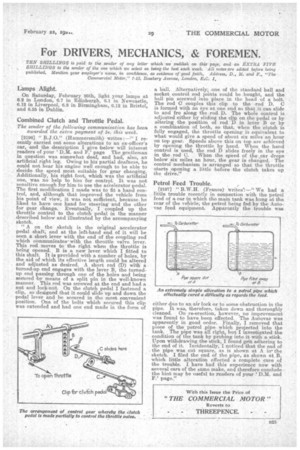For DRIVERS, MECHANICS, & FOREMEN.
Page 29

If you've noticed an error in this article please click here to report it so we can fix it.
TEN SHILLINGS is _paid to the sender of any letter which we publish an this page, and an EXTRA FIVE SHILLINGS to the sender of the one which we select as being the best each week. All notes are edited before being published. Mention your employer's name, in confidence, as evidence of good faith, Address. D., M. and P., "The Commercial Motor," 7-15, Rosebery Avenue, London, EX. 1,
Lamps Alight.
On Saturday, February 26th, light your lamps at 6.2 in London, 6.7 in Edinburgh, 6.1 in Newcastle, 6.12 in Liverpool, 6.8 in Birmingham, 6.12 in Bristol, and 6.55 in Dublin.
Combined Clutch and Throttle Pedal.
The sender of the following communication has been awarded the extra payment of 5s. this week.
[2196] " B.J.0." (Hammersmith) writes:---:" I recently carried out some alterations to an ex-officer's car, and the description I give below will interest readers of your D.M. and F.' page The gentleman in question was somewhat deaf, and had, also, an artificial right leg. Owing to his partial deafness, he could not hear his engine well enough to be able to decide the speed most suitable for gear changing. Additionally, his right foot, which was the artificial one, was no help to him for control. It was not sensitive enough for him to use the accelerator pedal. The first modification I made was to fit a hand control, and, although that improved the vehicle from his point of view, it was not sufficient, because, he liked to have one hand for steering and the other for gear change. Eventually, I coupled up the throttle control to the clutch pedal in the manner described below and illustrated by the accompanying sketch.
"A on the sketch is the original accelerator pedal shaft, and at the left-hand end of it will be seen it short lever with the end of the coupling rod which communicates-with the throttle valve lever. This rod moves to the right when the throttle is being opened. B is a new lever which I fitted to this shaft. It is provided with a number of holes, by the aid of which its effective length could be altered and adjusted as desired. A short rod (D) with turned-up end engages with the lever B, the turnedup end passing through one of the holes and being secured 'by means of a split pin in the well-known manner. This rod was screwed at the end and had a nut and lock-nut. On the clutch pedal I fastened a clip, so deaigned that it could slide -up and down the pedal lever and be scoured in the most convenient position. One of the bolts which secured this clip was extended and had one end made in the form of a ball. Alternatively; one of the standard ball and socket control rod joints could be bought, and the ball pin screwed into place in the head of a bolt. The rod C couples this clip to the rod D. C is formed with an eye at one end so that it can slide to and fro along the rod. D. The whole control is adjusted either by sliding the Clip on the pedal or by altering the position of rod D in lever B or by a combination of both, so that, when the clutch is fully engaged, the throttle opening is equivalent to what would give a speed of about six miles an hour on top gear. Speeds above this on top are achieved by opening the throttle by hand. When the hand control is used, the rod D slides freely in the eye in the rod C. When the speed of the car drops below six miles an hour, the gear is changed. The control mechanism is arranged so that the throttle starts opening a little before the clutch takes up the drive.?'
Petrol Feed Trouble.
[21971 " B.W.H. (France) tvrites*:—" We had a little trouble recently in connection with the petrol feed of a ear in which the main tank was hung at the rear of the vehicle, the petrol being fed by the Autovac feed equipment. _Apparently the trouble was either due to an air lock or to some obstruction in the pipe. It was, therefore, taken down and thoroughly cleaned. On re-erection, however, no improvement was found to have been effected. The Autovac was apparently in good order. Finally, I removed that piece of the petrol pipe which projected into the tank. The pipe was all right, but I investigated the condition of the tank by probing into it with a stick. "Upon withdrawing the stick, I found grit adhering to the end of it. Incidentally, I noticed that the end of the pipe was cut square, as is shown at A 1n the sketch. I filed the end of the pipe, as shown at B, which little alteration effected a complete cure of the trouble. I have had this experience now with several cars of the same make, and therefore conclude the hint may be useful to readers of your 'P.M. and F.' page."






























